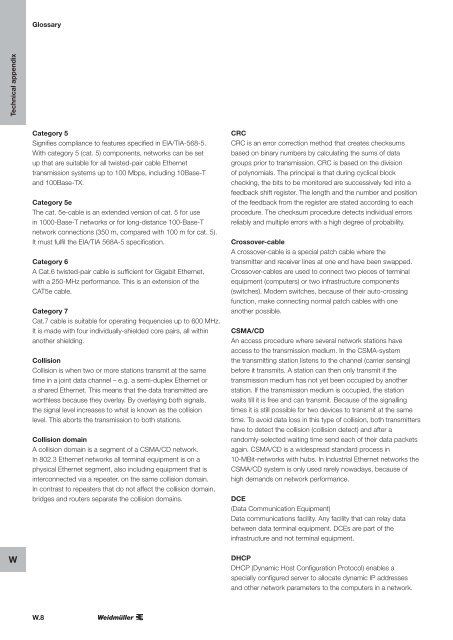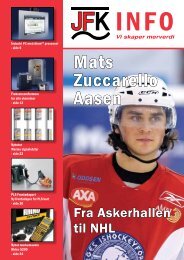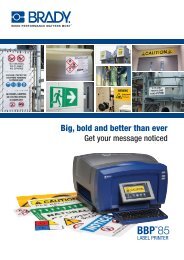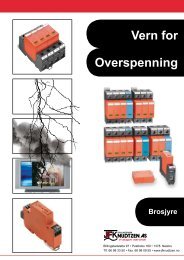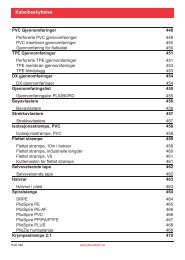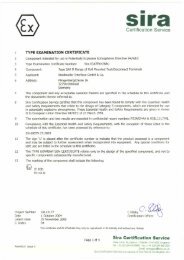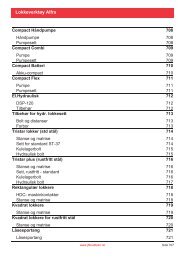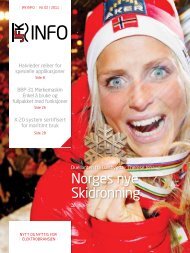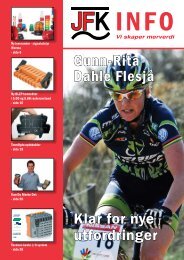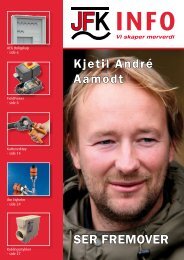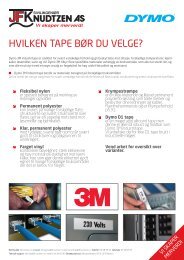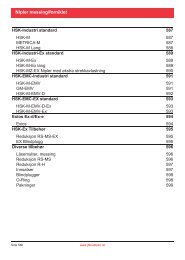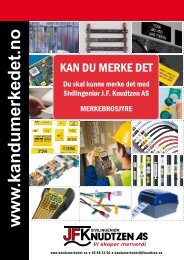Industrial Ethernet
Industrial Ethernet
Industrial Ethernet
Create successful ePaper yourself
Turn your PDF publications into a flip-book with our unique Google optimized e-Paper software.
GlossaryTechnical appendixCategory 5Signifies compliance to features specified in EIA/TIA-568-5.With category 5 (cat. 5) components, networks can be setup that are suitable for all twisted-pair cable <strong>Ethernet</strong>transmission systems up to 100 Mbps, including 10Base-Tand 100Base-TX.Category 5eThe cat. 5e-cable is an extended version of cat. 5 for usein 1000-Base-T networks or for long-distance 100-Base-Tnetwork connections (350 m, compared with 100 m for cat. 5).It must fulfil the EIA/TIA 568A-5 specification.Category 6A Cat.6 twisted-pair cable is sufficient for Gigabit <strong>Ethernet</strong>,with a 250-MHz performance. This is an extension of theCAT5e cable.Category 7Cat.7 cable is suitable for operating frequencies up to 600 MHz.It is made with four individually-shielded core pairs, all withinanother shielding.CollisionCollision is when two or more stations transmit at the sametime in a joint data channel – e.g. a semi-duplex <strong>Ethernet</strong> ora shared <strong>Ethernet</strong>. This means that the data transmitted areworthless because they overlay. By overlaying both signals,the signal level increases to what is known as the collisionlevel. This aborts the transmission to both stations.Collision domainA collision domain is a segment of a CSMA/CD network.In 802.3 <strong>Ethernet</strong> networks all terminal equipment is on aphysical <strong>Ethernet</strong> segment, also including equipment that isinterconnected via a repeater, on the same collision domain.In contrast to repeaters that do not affect the collision domain,bridges and routers separate the collision domains.CRCCRC is an error correction method that creates checksumsbased on binary numbers by calculating the sums of datagroups prior to transmission. CRC is based on the divisionof polynomials. The principal is that during cyclical blockchecking, the bits to be monitored are successively fed into afeedback shift register. The length and the number and positionof the feedback from the register are stated according to eachprocedure. The checksum procedure detects individual errorsreliably and multiple errors with a high degree of probability.Crossover-cableA crossover-cable is a special patch cable where thetransmitter and receiver lines at one end have been swapped.Crossover-cables are used to connect two pieces of terminalequipment (computers) or two infrastructure components(switches). Modern switches, because of their auto-crossingfunction, make connecting normal patch cables with oneanother possible.CSMA/CDAn access procedure where several network stations haveaccess to the transmission medium. In the CSMA-systemthe transmitting station listens to the channel (carrier sensing)before it transmits. A station can then only transmit if thetransmission medium has not yet been occupied by anotherstation. If the transmission medium is occupied, the stationwaits till it is free and can transmit. Because of the signallingtimes it is still possible for two devices to transmit at the sametime. To avoid data loss in this type of collision, both transmittershave to detect the collision (collision detect) and after arandomly-selected waiting time send each of their data packetsagain. CSMA/CD is a widespread standard process in10-MBit-networks with hubs. In <strong>Industrial</strong> <strong>Ethernet</strong> networks theCSMA/CD system is only used rarely nowadays, because ofhigh demands on network performance.DCE(Data Communication Equipment)Data communications facility. Any facility that can relay databetween data terminal equipment. DCEs are part of theinfrastructure and not terminal equipment.WDHCPDHCP (Dynamic Host Configuration Protocol) enables aspecially configured server to allocate dynamic IP addressesand other network parameters to the computers in a network.W.8


